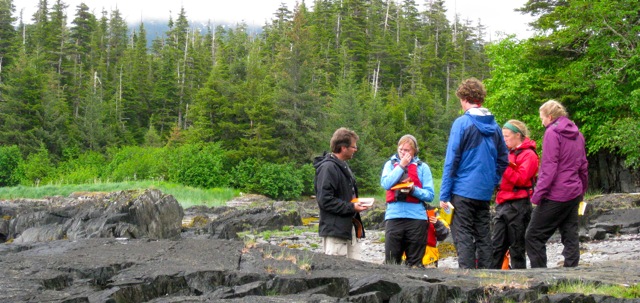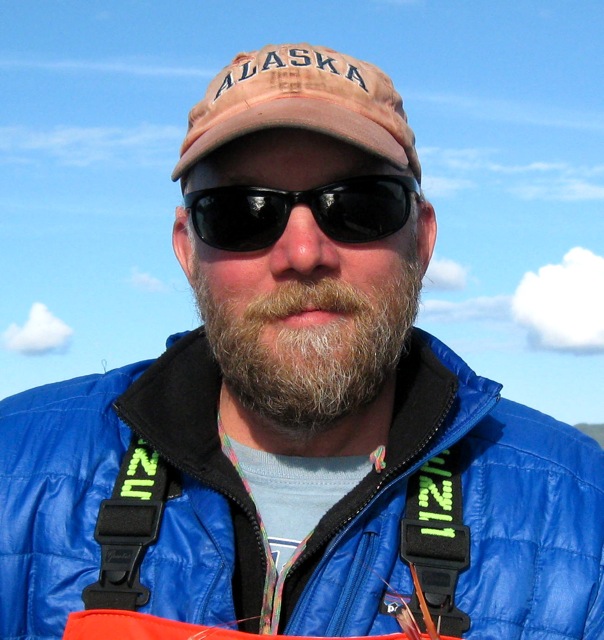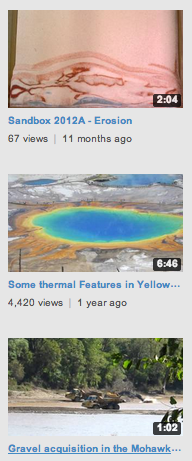Teaching the Geosciences in a Research-rich environment
My research is focused on low-temperature thermochronology and Cordilleran tectonics, flood hazards and watershed analysis, and the sediment record of environmental change. Much of my work with detrital zircon is aimed at a better understanding of radiation damage and how this affects geochronology.
My teaching is based on active learning in a research-like environment. I teach courses in Natural Disasters, Sedimentation and Stratgraphy, Tectonics, and Structural Geology. I am a Fellow and active member of the Geological Society of America.
Union Fission Track Lab
The Union Fission track Lab at Union College is one of the leading labs in the analysis of fission track in zircon, or at least we think so. We do traditional fission track studies to understand orogenic development, thermal studies related to fluids and ore forming events, and low-temperature studies in the analysis of basin maturation. A significnat fraction of our work involves understanding radiation damage in zircon. More...
Keck Geology Consortium
The Keck Geology is a multi-college collaboration focused on enriching undergraduate education through development of high-quality research experiences in the Geosciences. The Consortium has been a fundamental component of the undergraduate-research landscape since inaugural projects in 1987. Here at Union we are proud to be part of the Consortium and we are actively involved in running projects and mentoring students. The Keck Consortium and the research project that we run has been named one of seven "Programs that Work" by Project Kaleidoscope. In 2007 I co-led a project called Rocks and Rain in the Swiss Alps.
Alaska - the evolution of the Chugach-Prince William flysch
This multi-year project is focused on understanding the tectonic evolution of the Chugach-Prince William terrane in south central Alaska. This overall effort has been co-funded by the Keck Consortium and by the National Science Foundation. The focus of our effort is on the very thick rocks of the CPW terrane that were intruded by near trench plutons and then translated some controversial distance along the North American margin in the early Tertiary. I am co-leading a project with Cam Davison of Carleton College. Details of the our multi-year effort in southern Alaska is at this web page.
Mohawk Watershed
For a number of years we have been looking into flooding on the Mohawk River in upstate New York (USA). In doing so, we've been primarily focussed on understanding the conditions that surround historic floods so that we can better understand future hazards for the city of Schenectady and nearby communities. We've compiled a relatively long record of historical floods through a variety of archives, and we've studied ice jams and the dynamics of these ice jams. Some of our recent work has been focussed on determining the movement hisotry of landslides in the basin. The Fifth Mohawk Watershed Symposium is in March More...
Teaching
I find teaching fascinating and I enjoy getting students excited about science. I teach a number of field-intensive courses where students make observations, collect data, and then interpret those data in a meaningful way. I teach Sedimentology and stratigraphy, Structural geology, Earth and life through time, and Geologic Hazards. Most course information is posted internally (Moodle). On an irregular basis I teach Carbonate Sedimentology,and Living on the Edge and other FIELD Programs. I have several videos that illustrate Geologic Processes (at YouTube), including analog models for the development of orogenic wedges that are made in our sandbox.
Key publications
Peterson, V.L., Garver, J.I., Semken, S., and Williams, W.J., 2011. Enhancing participation of two-year college faculty in the Geological Society of America; GSA Today, Groundwork Article. (PDF)
Wang, A., Garver, J.I., Wang, G., Smith, J.A., Zhang, K, 2010, Episodic exhumation of the Greater Himalayan Sequence since the Miocene constrained by fission track thermochronology in Nyalam, central Himalaya, Tectonophysics, p. 315-320. (PDF)
Batt, G.E., Cashman, S.M., Garver, J.I., and Bigelow, J.J., 2010. Thermotectonic evidence for two-stage extension on the Trinity detachment surface, Eastern Klamath mountains, California; American Journal of Science, v. 310, p. 261-281. (PDF)
Enkelmann, E., Zeitler, P.K., Garver, J.I., Pavlis, T.P. and Hooks, B.P, 2010. The thermochronological record of tectonic and surface process interaction at the Yakutat–North American collision zone in southeast Alaska; American Journal of Science, v. 310, p. 231-260. (PDF)
Marsellos, A.E., Garver, J.I., 2010, Radiation damage and uranium concentration in zircon as assessed by Raman spectroscopy and neutron irradiation; American Mineralogist, Volume 95, pages 1192–1201.(PDF)
Marsellos, A.E., Kidd, W.S.F., and Garver, J.I., 2010. Extension and exhumation of the HP/LT rocks in the Hellenic foreare ridge; American Journal of Science, v. 310, p. 1–36. (PDF)
Bernet, M., Brandon, M., Garver, J., Balestieri, M.L., Ventura, B., and Zattin, M, 2009, Exhuming the Alps through time: clues from detrital zircon fission-track thermochronology. Basin Research, v. 21, Issue 6, p. 781–798. (PDF)
Hourigan, J., Brandon, M.T., Soloviev, A.V., Kirmasov, A.B., Garver, J.I., Stevenson, J., and Reiners, P.W., 2009. Eocene arc-continent collision and crustal consolidation in Kamchatka, Russian Far East. American Journal of Science. v. 309: p. 333-396. (PDF)
Meigs, A., Johnston, S., Garver, J.I., and Spotila, J., 2008, Crustal-scale structural architecture, shortening, and exhumation of an active, eroding orogenic wedge (Chugach/St Elias Range, southern Alaska), Tectonics, v. 27, TC4003, 26 pp. (PDF)
Montario, M.J., and Garver, J.I., 2009, The thermal evolution of the Grenville Terrane revealed through U-Pb and Fission-Track analysis of detrital Zircon from Cambro-Ordovician quartz arenites of the Potsdam and Galway Formations; Journal of Geology, vol. 117, no. 6, p. 595-614. (PDF)
Draper, S., Evans, J., Garver, J.I., and Kirschner, D. and Janecke, S.U. 2009, Arkosic rocks from the San Andreas Fault observatory at Depth (SAFOD) borehole, central California: implications for tectonics along the San Andreas Fault. Lithosphere 1; p. 206-226.(PDF)
Gombosi, D.J., Barbeau, D.L., Garver J.I., 2009. New thermochonometric constraints on the rapid Paleogene exhumation of the Cordillera Darwin complex related thrust sheets in the Fuegian Andes. Terra Nova, v. 21, n. 6, p. 507–515. (PDF)
Enkelmann, E., Zeitler, P.K., Pavlis, T.L., Garver, J.I., Ridgway, K.D. 2009. Intense Localized Rock Uplift and Erosion in the St. Elias Orogen of Alaska. Nature Geoscience 2, no. 5, p. 360-363. (PDF)
Enkelmann, E., Garver, J.I., and Pavlis, T.L., 2008, Rapid exhumation of ice-covered rocks of the Chugach-St. Elias Orogen, Southeast Alaska. Geology, v. 36, n.12, p. 915-918. (PDF)
Perry, S.E., Garver, J.I., and Ridgeway, K., 2009, Transport of the Yakutat Terrane, southern Alaska, evidence from sediment petrology and detrital zircon fission-track and U/Pb double dating. Journal of Geology. V. 117, n. 3. p. 156-173. (PDF)
Fellin, M.G., Vance, J.A., Zattin, M., Garver, J.I., 2006. The Thermal evolution of Corsica as recorded by zircon fission tracks, Tectonophysics, 421, 299-317. (PDF)
Bernet, M., and Garver, J.I., 2005, Chapter 8: Fission-track analysis of Detrital zircon, In P.W. Reiners, and T. A. Ehlers, (eds.), Low-Temperature thermochronology: Techniques, Interpretations, and Applications, Reviews in Mineralogy and Geochemistry Series, v. 58, p. 205-237. (PDF)
Garver, J.I., Reiners, P.R., Walker, L.J., Ramage, J.M., Perry, S.E., 2005, Implications for timing of Andean uplift based on thermal resetting of radiation-damaged zircon in the Cordillera Huayhuash, northern Perú, Journal of Geology, v. 113, n. 2, p. 117-138. (PDF)
Rahn, M.K., Brandon, M.T., Batt, G.E., and Garver, J.I., 2004, A zero-damage model for fission-track annealing in zircon. American Mineralogist, v. 89, n. 3. p.473-484. (PDF)
Garver, J.I., 2002, Etching age standards for fission track analysis; Radiation Measurements, v. 37, n. 1, p. 47-54.(PDF)
Garver, J.I., 2008, Fission-track dating. In Encyclopedia of Paleoclimatology and Ancient Environments, V. Gornitz, (Ed.), Encyclopedia of Earth Science Series, Kluwer Academic Press, p. 247-249. (PDF)
Garver, J.I., 2002, Discussion: "Metamictization of natural zircon: accumulation versus thermal annealing of radioactivity-induced damage." Contributions to Mineralogy and Petrology, v. 143, p. 756-757. (PDF)
Garver, J.I., and Kamp, P.J.J., 2002, Integration of zircon color and zircon fission track zonation patterns in Orogenic belts: Application of the Southern Alps, New Zealand; Tectonophysics. v. 349, n. 1-4, p. 203-219. (PDF)
Garver, J.I., Soloviev, A.V., Bullen, M.E., and Brandon, M.T., 2000, Towards a more complete record of magmatism and exhumation in continental arcs using detrital fission track thermochronometry; Physics and Chemistry of the Earth, v. 25, n. 6-7, p. 565-570. (PDF)
Garver, J.I., Brandon, M.T., Roden-Tice, M., and Kamp, P.J.J., 1999, Erosional denudation determined by fission-track ages of detrital apatite and zircon, in Ring, U., Brandon, M.T., Willett, S., and Lister, G. (editors), Exhumation Processes: Normal Faulting, Ductile Flow, and Erosion, Geological Society of London Special Publication 154, p. 283-304. (PDF)
Brandon, M.T., Roden-Tice, M.R., and Garver, J.I., 1998, Late Cenozoic exhumation of the Cascadia accretionary wedge in the Olympic Mountains, northwest Washington State, Geological Society of America Bulletin, v 100, p. 985-1009. (PDF)
Cowan, D.S., Brandon, M.T., and Garver, J.I., 1997, Geologic tests of hypotheses for large coastwise displacements - A critique illustrated by the Baja British Columbia Hypothesis, American Journal of Science, v. 297, p. 117-173. (PDF)
Garver, J.I., Royce, P.R., and Smick, T. A., 1996, Chromium and nickel in shale of the Ordovician Taconic Foreland: a case study for the provenance of sediments with an ultramafic provenance; Journal of Sedimentary Research, v. 66, n. 1, p. 100-106.(PDF)
Garver, J.I., and Scott, T.J., 1995, Rare earth elements as indicators of crustal provenance and terrane accretion in the southern Canadian Cordillera, Geological Society of America Bulletin, v. 107, n. 4, p. 440-453. (PDF)
Garver, J.I., and Brandon, M.T., 1994, Erosional denudation of the British Columbia Coast Ranges as determined from fission-track ages of detrital zircon from the Tofino Basin, Olympic Peninsula, Washington, Geological Society of America Bulletin, v. 106, n. 11, p. 1398-1412. (PDF)
Garver, J.I., Royce, P.R., and Scott, T.J., 1994, The presence of ophiolites in tectonic highlands as determined by chromium and nickel anomalies in synorogenic shale: two examples from North America: Russian Geology and Geophysics, v. 35, n. 2, p. 1-8. (PDF)
Garver, J.I., Archibald, D.A., and Van Order, W.F., 1993, Late Cretaceous to Paleogene cooling adjacent to strike-slip faults in the Bridge River area, Southern British Columbia, based on fission-track and 40Ar/39Ar analyses; Geological Survey of Canada, Current Research, 94-1A, p. 177-183. (PDF)
Garver, J.I., 1988, Fragment of the Coast Range Ophiolite and the Great Valley sequence in the San Juan Islands, Washington; Geology, v. 16, n. 11, p. 948-951. (PDF)
Garver, J.I., 1988, Stratigraphy and tectonic significance of the clastic cover to the Fidalgo Ophiolite, San Juan Islands, Washington; Canadian Journal of Earth Sciences, v. 25, n. 3, p. 417-423. (PDF)
Here is an incomplete list of these and all other PUBLICATIONS. Papers and abstracts are tracked here by GOOGLE SCHOLAR.

Colleague Cam Davidson (Carleton College) discusses the Paleocene Orca Group, Eshamy Bay, Alaska

